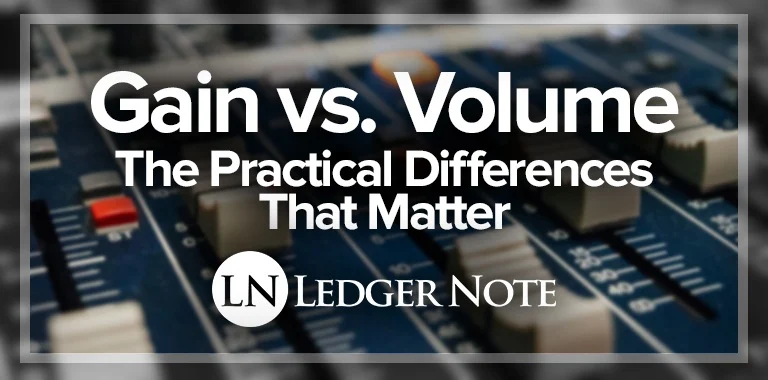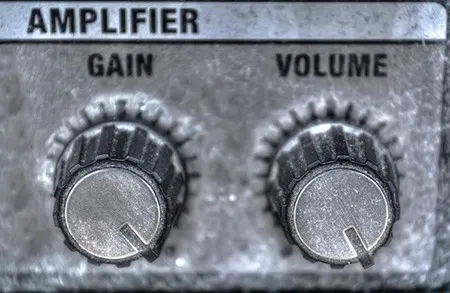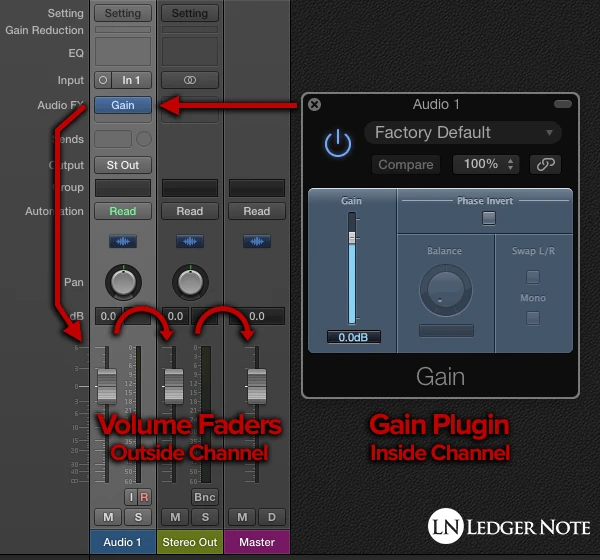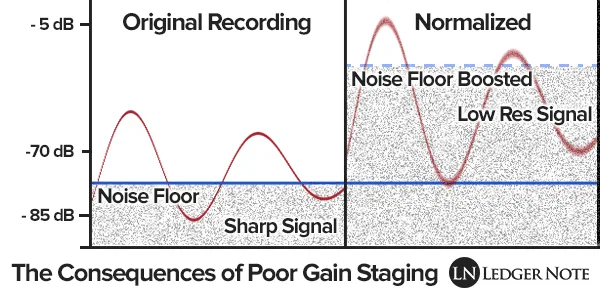
At some point, no matter if you’re learning to record music, be a mixing engineer, toying with your first guitar pedals, you’ll be asking the question “What’s the difference between gain and volume?”
To the untrained mind, they seem like they’re the same. They both make audio louder when you increase them. The sound of changing either might seem identical to you now, and maybe that’s true if you’re dancing in an acceptable range of gain.
But there are a lot of various components in your signal path, whether analog or digital, that can go haywire if you don’t understand the effect of gain versus how volume works. Fortunately it’s a piece of cake.
A result of getting it right is higher resolution recordings with lower noise floors, more clarity, more headroom, and a cleaner and greater dynamic range in regards to amplitude. Let’s jump right in so you can apply these lessons to your mixes and recordings, pronto.
Gain vs. Volume – Understanding Each Separately
Before we can effectively compare these two properties of audio, we need to make sure we understand what each is separately. Keep in mind that both modulate the amplitude of a signal, which translates into a change in loudness.

No wonder people are confused. In the image above we have two knobs right next to each other that seem to do the exact same thing. Not quite!
What is Volume?
Volume is exactly what you’re probably thinking and used to dealing with. You turn the knob on your car radio and the speakers get louder. You push up the fader on a mixing console and that track gets louder. There’s no real, practical mystery here.
Volume is a measure of the output of an audio system as measured in decibels (dB). You can think of a sound system as a set of speaker monitors, headphones, an airplane, a chainsaw, or someone whispering in your ear.
A “system” in this case can be anything that produces sound. And the volume can be measured on the decibel scale. The higher the decibels, the louder the sound is. There’s more to mention about sound pressure levels (SPL) and sound intensity, but let’s not overcomplicate things for now.
The thing to understand is you can adjust the volume of a sound system and it won’t affect the quality or tone of the audio signal. Even if your speakers begin to distort, the audio signal remains the same. Volume happens at the output, making it incapable of affecting audio quality.
Now, let’s juxtapose that against gain, and the difference should pop out at you based on what I’ve emphasized about volume. If it doesn’t, don’t worry. I’ll do a direct comparison right after.
What is Gain?
Gain is the ratio between the volume at the input and the volume at the output of an electrical circuit. That’s what it actually is, despite every other website telling you it’s just “the volume at the input.”
It gets more complicated, dealing with voltage and current in electronics (everything we use to record). Amplitude is measured in voltage, which is a direct corollary to volume.
These sites just want it to be easier for you to understand, because that makes gain the opposite of volume. It’s an easier way to think about it, but it’s not necessarily the full truth.
The problems are that some people don’t understand gain but think they do. Some professionals get it but don’t care about misusing the term since everyone else does.
An example is on any gain-reducing plugin or hardware unit, they’ll often label the output volume as “makeup gain,” which is incorrect but a convention now.
For practical purposes, you can think of gain as volume at the input until you have a deeper grasp on it, that I’ll provide as we continue. The real question is why do we need that level of control at the start of a signal chain? I’ll tell you in a second.
The Difference Between Gain and Volume
In plain language, Gain is kind of like an amplitude knob at the input of a piece of hardware or software that controls the loudness before it goes through the circuitry. Volume is an amplitude knob that controls loudness after it has passed through the electronics.

We all understand what a volume knob is for and how to use it. Remember that volume doesn’t affect the quality or tone of a sound. It just turns the entire system up in loudness.
Tweaking the gain knob definitely affects the quality and tone of a sound. Remember that gain is the ratio of the amplitude of the output divided by the input amplitude. Now consider a “system” of audio and think of it as a contained signal path made of electronics.
In analog audio, there is a peak amplitude (based on voltage) possible before you can’t get any louder. In digital audio, there’s also a peak amplitude allowed based on the bit depth of the system. This can get real complicated and I recommend you read our article about headroom if you want to dig deep.
The point is, there’s a maximum loudness inside an audio system before you start experiencing distortion (as controlled by gain), but there’s no maximum loudness outside of the system at the output (as controlled by volume).
That’s the key difference between gain and volume. Now the question is what does gain do and how does it affect our audio quality.
What Does Gain Do?
Let’s take three easy to understand examples that you’ve likely dealt with. The first is that of a microphone preamplifier, the second is that of an analog-to-digital converter, and the third is a guitar amplifier.
They’re all simple signal paths but have different scenarios at the output, which makes this easy to understand.
Scenario #1 – Microphone Preamps
Every newcomer plugs in their first microphone and records a take and wonders why the heck the volume is so low. So they turn up that recording to an acceptable level (at the system’s output) but it has a ton of noise in it. Why is this the case?
Microphones record at what is called “mic level,” which is a very quiet signal because there’s not a lot of amplitude. It has to do with how microphones are made and how they need to be very sensitive to be able to pick up minute details in the audio they’re capturing.
So what has to happen is you have to turn up the volume on the microphone’s signal at the input. This is done with a microphone preamp. You have to use one, there’s no escaping it. Learn more in our “what is a preamplifier” article if needed.
The reason this is done is because every audio signal has a noise floor, a low level of electronically produced noise in it. So you need the volume of the actual, valuable audio in the signal to be much louder than the noise floor, otherwise you get a noise recording when you turn up the volume at the output.

A preamp does this for you. The best mic preamps can offer around 60 dB of gain, and the more the merrier to get over the noise floor. This is the main purpose of a preamp’s gain knob, but there’s more to the story in the next scenario.
This is an example of how gain improves quality by amplifying (increasing amplitude) above the inherent noise of an audio system. Let’s look at another way it improves audio when you’re actually recording.
Scenario #2 – Analog-to-Digital Converter
Let’s continue with this audio we’ve recorded with a microphone after we sent it through the preamp. It will next pass through an analog-to-digital converter (ADC), which exists in your computer’s soundcard or in an audio interface. As you know, there are okay ADC’s and better ones, but they all have amplitude limits.
This ADC converts physical electrical signals into digital ones your computer can understand. It reads the voltage and current to understand the loudness and frequencies involved in the audio. The situation is that there is an optimum loudness level that allows the ADC to create the highest quality recording.
It boils down to the fact that you want the loudest possible audio going through this converter so that it can fill the bits of data with the most information possible. The more information, the higher the quality of the audio playback from the computer.
But if you go too loud, you’ll get distortion in the form of audio clipping due to there being a maximum voltage allowed within the system.
This is the final reason we have input gain knobs. By riding as close as possible to the maximum voltage, we produce the highest quality audio allowed by the system. As a side note, limiters exist to keep you from accidentally clipping. The more you know!
Scenario #3 – Guitar Amplifiers
Think about a heavy metal guitarist that wants nasty distortion on purpose. They run into two problems. The first is they only have a volume knob which can’t produce enough loudness in voltage to cause distortion at the amplifier (yeah, some guitars have do gain knobs, I know).

The second problem is if they pump in too much voltage they can cause damage to their amplifier’s tube or to the speaker itself. This is exactly how we used to (and many still do) produce distortion for a guitar. But there’s a better way.
Instead of turning up the volume (at the output of the guitar) and then pulverizing the encapsulated system of the amplifier, we can just hit the maximum voltage of a guitar pedal designed for this purpose. So we use a boost pedal and/or just our best distortion pedal and push the sound gain on those to peak out inside their electronics.
From the distortion pedal, we’ll output a distorted signal to the amplifier which gets played as a distorted signal even though it’s not distorting at the amplifier itself. This means we can feed the amplifier a signal at a safe volume for the amp and still get the same effect, thanks to the audio gain on the enclosed guitar pedal system.
The key to understanding gain is to think of each component in a signal path as its own, independent “audio system” with its own input and output levels.
There’s an entire science and art to this called gain staging, which we’ve written about already for you to explore. It’s extremely important and everyone working in music must know about it if they want top (or even acceptable) audio quality.
Gain vs Volume – Easy to Understand!
If you really want to go into some interesting territory, you can explore how in acoustics, loudness is really subjective and our sense of volume varies at differing frequencies. It’s been mapped out in equal-loudness contours called the Fletcher-Munson curve.
As far as gain and volume go, you should know totally understand the difference. To recap, volume is a control of the loudness at the output of a sound system and has no affect on quality, while gain lets you increase the loudness inside of an audio system, which absolutely determines the quality of the sound or recording.
You may be a curious non-musician, but if you’re at all involved in music please visit our gain staging article to get a full grasp on this. You must use gain right if you care about quality at all. Understanding gain vs. volume is easy, using gain correctly is a bit more involved but more than worth your time.